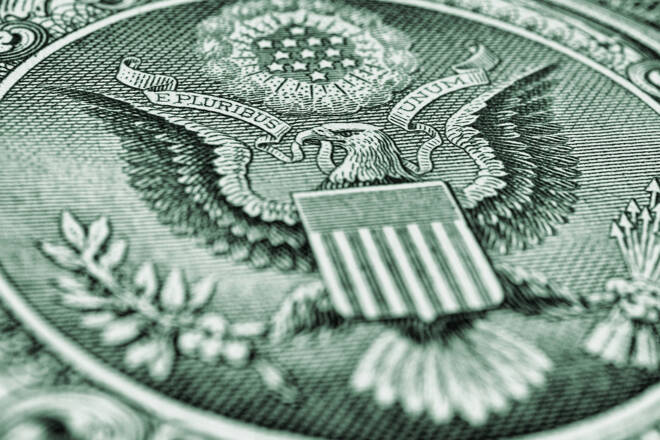Advertisement
Advertisement
Is The US Dollar (finally) Peaking?
By:
The US dollar turned weaker across the board last week on the back of expectations that we are past peak Fed hawkishness. Have we seen the USD peak, and could it drift lower from here?
In short
Following the ECB’s 75 basis point hike, markets are preparing for a shift from monetary policy divergence, which had been supportive for the dollar, to monetary policy convergence. Aside from the ECB, the SNB and the BoE have also signalled their willingness to act more forcefully. This has certainly removed some appeal from the US dollar. Nonetheless, we doubt that USD could experience a significant drop in the short term as growth and recession fears continue to provide support.
US Dollar Near Decade Highs
The US dollar has surged dramatically against the world’s biggest currencies this year. The greenback is up 13% against the euro, 15% against the British pound, and 20% against the Japanese yen year-to-date.
The US dollar index (DXY), which tracks the relative value of the US dollar against a basket of important world currencies, has surged to its highest level since 2002. The index has risen 15% this year, putting it on track for its biggest annual rise since 1981.
Underpinning the dollar’s seemingly unstoppable surge is the Federal Reserve, coupled with doubts about the global economy. To dampen rampant inflation, the US central bank has embarked on the most aggressive interest-rate hikes since the 1980s, raising interest rates by 2.25% since March. Looking at market pricing, traders expect this tightening to continue into 2023, with a ceiling near 4%.
Resilient US Economy Boosts Dollar Demand
Another factor in favour of the greenback has been deteriorating growth perspectives overseas. The meteoric rise in USD, which has led to a weaker euro, pound and yen, has worsened inflation problems in Europe, the UK and Japan, and hence has heaped pressure on policymakers to follow the Fed with aggressive rate hikes.
But the reality is that while the Fed has the luxury of sounding hawkish as the US economic data remain resilient, other central banks, especially the ECB and the BoE, do not enjoy the same leeway as their economies are already struggling with consequences from the Ukraine war. Therefore, hiking rates in this region may just worsen the slowdown and increase the odds of recession. This is why investors have preferred to hold on to the dollar.
The renewed sell-off in Treasuries this month has also again widened the yield gap between the US and Japan, pushing the yen to a 24-year low and on track for its worst year on record. This has prompted the strongest warnings to date from senior Japanese officials. Finance Minister Shunichi Suzuki said « «We’ll keep watching the markets with a high sense of urgency, and if the moves continue, we’ll respond as needed».
Despite the salvo of official warnings last week, the comments were insufficient to reverse the yen’s slide in the face of intense dollar strength. Many analysts expect that a stronger ramping up of language or possibly the calling of a trilateral meeting between the Bank of Japan, finance ministry and financial regulator in response to the sharp slide could prove more impactful.
Technical Analysis
Looking at the EURUSD and bearing in mind that much bad news is already priced into the single currency (including geopolitics, inflation and increased recession risk) – a new near-term base may be seen near parity, with higher risks to the upside should the ECB deliver on its expected rate hikes while containing a crisis in the bond market.
Regarding sterling, after another 10% sell-off in GBPUSD throughout the first half of the year and a currency that looks historically cheap and undervalued, the pound is likely to underperform peers, given domestic economic problems and political distractions.
Considering the yen, chances for continued yield-driven underperformance are high. Indeed, a BOJ rate hike seems off the agenda for now. BOJ intervention threats may resurface, but only coordinated action, which we see as unlikely for now, can reverse the trend. Ultimately, a BOJ policy U-turn and/or softer Fed will alter the yen’s fortunes, but we aren’t there yet.
Risk
Overall, we expect the dollar to hold up well over the coming months, supported by high interest rates and a resilient US economy. Nonetheless, it should be noted that USD valuations are stretched, with the currency near a 20-year high against a basket of major currencies. Moreover, Fed tightening assumptions are at peak hawkishness, which indicates the rate hike cycle may be nearing its end stages.
Looking ahead
Inflation and central banks’ tightening plans should continue to drive G-10 forex, but as we enter 3Q, growth and recession considerations could take a central role for the dollar. And although the currency may be overvalued, this isn’t enough reason to give up on the buck altogether, as there is still too much macro, earnings and geopolitical uncertainty to abandon defensive views.
Esty Dwek, CIO
About the Author
Esty Dwekcontributor
As a member of the Executive Committee and FlowBank's Chief Investment Officer (CIO), Esty is responsible for the investment strategy of the Bank. She also heads the Market Research department and plays a key role in developing the bank's educational offerings, among other things. She is also in charge of the Bank’s product offering.
Advertisement
